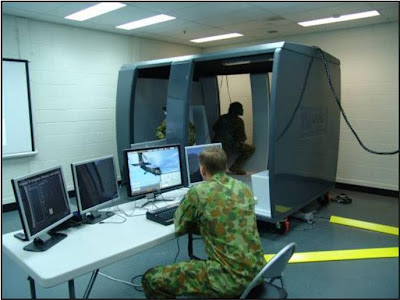26 Juli 2012
Improved graphic realism in VBS2 version 2.0. (photo :
ITNews)
The Australian Defence Force has upgraded a seven-year-old
core battlefield simulation system used to prepare individuals and teams of up
to 100 soldiers for battle.
Army personnel have used the Virtual Battle Space (VBS)
simulator since 2005, when VBS1 was used to train soldiers deploying to Iraq.
Defence licensed VBS2 2.0 from system developer Bohemia
Interactive for $2.8 million this month to improve terrains, viewing distances,
artificial intelligence and other features. The upgrade will be rolled out in
the third quarter of 2012.
A Defence spokesman told iTnews that the upgrade would
provide "a range of technical improvements, such as longer viewing
distances, improved networking support, increased processing power and much
larger maps".
"Typically, VBS2 is used by individual soldiers and
combat teams of over 100 soldiers," he said, noting that its uses included
tactical training and Area of Operation (AO) familiarisation.
"[It] can simulate a wide range of military
capabilities including naval and air capabilities ... most of the Australian Defence
Force and a range of coalition weapons systems [are] represented."
The upgraded simulator was expected to deliver a wide range
of foundation war fighting and mission specific scenarios — such as operations
in urban terrain.
The ADF's Aircrewman Virtual Reality Simulator uses VBS2 as
its image generation and training scenario software. (photo : ITNews)
"Army has, or is in the process of developing, terrains
for all of our key training ranges and other areas that support
mission-specific training of our personnel," the spokesman said, noting
that the VBS could simulate any land, sea, or air platform to varying levels of
fidelity.
Among other new features, VBS2 2.0 will introduce full
terrain paging, armored and aviation enhancements, realistic underwater and
scuba diving and improvements to parachuting and free-fall simulations.
The upgrade also provides trainees with more realistic AI
behavior. New computer-controlled units have a much better understanding of
their surrounding terrain, allowing them to move through smaller spaces and use
various features of the terrain for cover.
New maps will cover a maximum virtual distance of 300 x 300
kilometres; up from 100 x 100 kilometres in the previous version.
The spokesman said VBS2 2.0 would support scenarios, models
and data sets from earlier versions. The existing PC fleet will be used to run
the upgraded VBS2 system.
"[VBS2 2.0 is] one of Army's core simulation systems
[which is] used for a wide range of training tasks," the spokesman said.
"It complements other virtual simulations, such as
helicopter and armoured fighting vehicle virtual simulators that focus on
psycho-motor skills."
Defence currently runs the Virtual Battle Space simulator on
about 1000 desktop machines and 150 laptops, the majority of which are within
the Battle Simulation Centres located in Darwin,
Townsville, Brisbane, Adelaide and Puckapunyal.
The view inside the virtual cockpit. (photo : ITNews)
"Typically PCs [designed to run VBS2] have an Intel i5
or i7 CPU, 4GB RAM, 1GB NVIDIA Video Card and 1 Gab network card," the
spokesman said.
"Some of these PCs are also fitted with specialised
interface devices that replicate the controllers found on armoured vehicles,
helicopters and other military platforms."
Serious games
The Australian Army is said to be one of the first
organisations to use the VBS product for collective military tactical training
and mission rehearsal.
Defence's spokeperson said it did not consider the VBS as a
gaming system. However, a version of the product was available for Defence
personnel to use on their home computers along with commercial variants.
Other VBS customers include the British Ministry of Defence, Singapore
Armed Forces and NATO.
In January 2009, the United States Army deployed a new
training program based on the VBS2 simulator engine to address training gaps
identified in small unit operations in Iraq
and Afghanistan.
Bohemia Interactive comprises a number of privately owned
software development companies based in the US,
Australia and the Czech Republic.
Prior to netting military simulation contracts, the group
was chiefly known for producing action-themed video games such as Operation
Flashpoint, a military shooter that provided the template for VBS2.








































